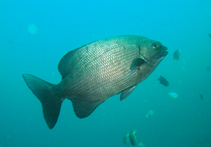| Family: |
Kyphosidae (Sea chubs) |
| Max. size: |
53 cm FL (male/unsexed); max.weight: 3,606.0 g |
| Environment: |
reef-associated; marine; depth range 0 - 45 m |
| Distribution: |
Indo-Pacific: Red Sea and East Africa to the Hawaiian, Line and Tuamoto islands, north to southern Japan, south to Australia. |
| Diagnosis: |
Dorsal spines (total): 11-11; Dorsal soft rays (total): 11-12; Anal spines: 3-3; Anal soft rays: 11-12. Description: Grey with dusky fins. When small or sub-adult with pale scale centers forming horizontal lines along scale rows. Soft parts of dorsal and anal fins elongated anteriorly, resulting in near vertical rear margins. Snout more angled down compared to other species (Ref. 48636). Head dorsal profile protuberance on anterior of upper side of eye; maxillary reaches to posterior of front of eye. Body depth 2.3-2.8 in SL, HL 3.4-3.7 in SL. Dorsal fin soft rays elevated higher than spines, spinous base longer than soft part, longest spine 1.3-1.7 in longest soft ray (Ref. 90102). |
| Biology: |
Found in aggregations over hard, algal coated bottoms of exposed, surf-swept outer reef flats, lagoon and seaward reefs, to a depth of at least 24 m (Ref. 30573). Benthopelagic (Ref. 58302). Juveniles associated with floating material (Ref. 58302). Mainly herbivorous, feeding on seaweed and associated invertebrates (Ref. 30573). Appear to be more commonly involved in hallucinogenic fish poisoning than most other related species (Ref. 4690). Caught with other types of artisanal gear. Minimum depth reported taken from Ref. 128797. |
| IUCN Red List Status: |
Least Concern (LC); Date assessed: 07 July 2014 Ref. (130435)
|
| Threat to humans: |
poisonous to eat |
Source and more info: www.fishbase.org. For personal, classroom, and other internal use only. Not for publication.

